Time for the one that most people have been waiting for.....

With the feedback on The 5th to the 1st, in Strange Tales being universally positive and with things like Platoon hot at the box office, Jim Shooter showed a mock-up cover of a new comic, with an image from a GI JOE cover, and a title logo, The 'Nam. He asked Larry Hama to develop a pitch for a series and he conceived the idea of telling the story of a tour of duty in Vietnam, with each issue representing one month's time. He again got the team of Doug Murray and Michael Golden involved and they launched a surprise hit. In 1986, war comics were pretty much done. DC's long run of titles had mostly ceased, apart from the odd special or mini-series. Marvel had put Sgt Fury to bed earlier, in 1981. Meanwhile, those that had lasted had primarily been focused on World War 2, which was seen by the general public as a "just war," if there is such a thing and had used a recurring character or feature. With the conceit that this would be a single tour of duty, you automatically limit the potential lifespan of a character, within the series, to 12 or 13 issues; fine for a mini-series; but this was to be ongoing. Still that's the way they went.
The first year of The Nam is seen through the eyes of Pvt Ed Marks, who as the first issue opens, is boarding a plane to South Vietnam, to start his one year tour of duty. His parents are there to see him off...
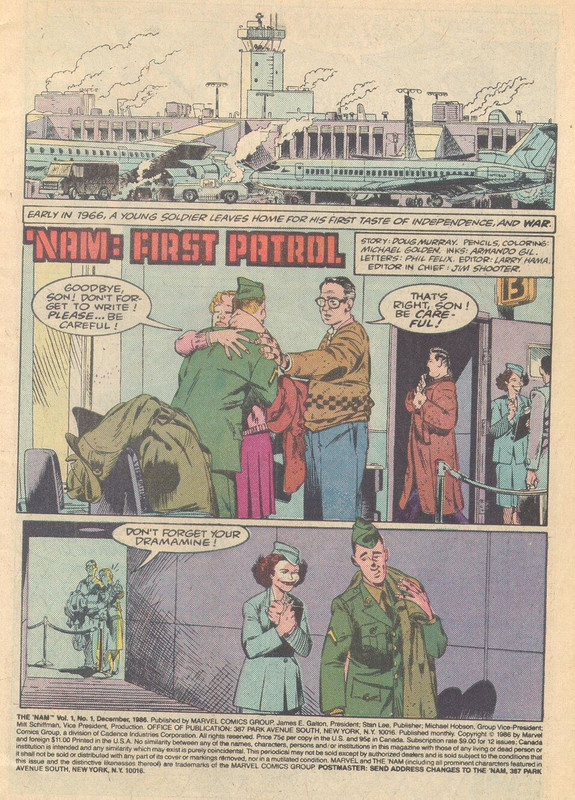
"Aw, Mom; not in front of the airline lady!"
The year is 1966. The US is engaging in offensive military operations in Vietnam. The entire 25th Infantry Division is deployed to Vietnam. It is in this division that Ed Marks is assigned. He is first sent to Ft Lewis, Washington, where he is run through a physical, given 3 different injections for various diseases, issued his gear and put on a military plane, bound for Saigon. Ed has trouble with air sickness and doesn't get much sleep. They arrive in the dark and Ed notices some green lights in the sky....
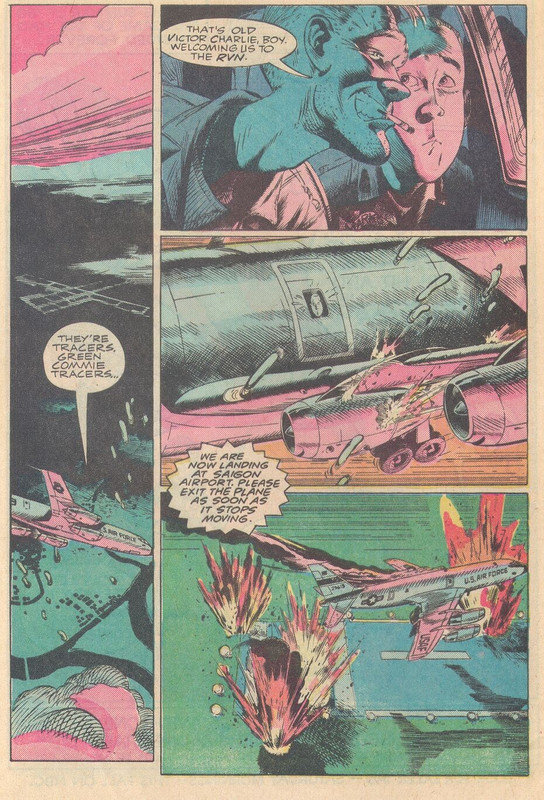
Welcome to Viet-f@#$%&g-Nam!
The men are rushed off the plane to trucks, to take them to the "Repo Depot," (replacement depot), where they will be assigned to their new unit. Ed is given malaria pills, then put on another vehicle to his final destination, the 4th Battalion, 23rd Infantry (Mechanized). He reports to the 1st sergeant who asks him what kind of duty he wants. Ed doesn't know how to answer and the Top (1st sergeant) is less than happy, calls over another soldier and tells him to show ed to Sgt Polkow. Ed is then educated on how things are, in The nam, instead of "The World." The 1st sergeant wanted a bribe to have him assign Ed to cushier duty. Ed's naive response made him think that Ed was being funny, so he assigned him to Polkow's platoon, which he hates. Ed meets the others and his platoon sergeant and is told to get settled in, as they will be going into the bush at 0430 (that 4:30 am, for you civilian pukes......we do more killing before 5:00 am than most people do all day.....except for McDonalds, who do a steadier business in poisoning!)
All around the base (which is surrounded by razorwire, has sandbagged observation posts with machine guns, and helos landing and taking off, we see men going about their business, like an APC (armored personnel carrier) with a crane arm, removing a wrecked Huey.
The next morning finds Ed humping through his first rice paddy, with a stop along the way to show him an anti-personnel mine, laid on the trail, waiting for some inattentive GI t step on it and lose a leg...or worse. Ed is sweating bullets, from both the tropical heat and the intensity of concentration. They take a break and fill canteens, where Ed's new buddy, Mike Albergo, shows him how to skim off the pondscum at the top and fill the canteen, then drop iodine purification tablets into it and shake it up, letting the tablets dissolve before drinking any. He warns Ed of the lousy taste. They are on a search-and-destroy mission: flush out Charlie and shoot him. They come to a village and spread out, so that they aren't bunched together in a column, that could easily be mowed down. Someone notices the locals bugging out and yells a warning. They take incoming fire and return it. Ed is stunned, at first, but reacts to the sergeant telling him to open fire and he does. They move out to chase down Charlie and Ed encounters his first dead body and leaves his breakfast on the ground.
They stop for a break, then meet up with APCs, transporting Australian soldiers, who are there to reinforce their patrol. They come across the area marked as potential VC territory and search for signs in what looks like a quiet clearing, until a trapdoor pops open...
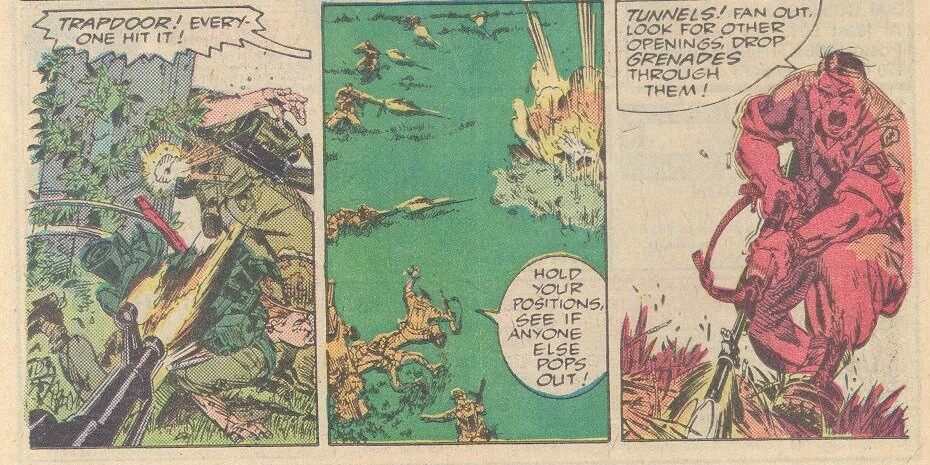
The men hunt for other openings and drop grenades into any they find. The sergeant then radios in and marks an LZ (landing zone) and in come the Hueys, with reinforcements and transport. Ed is still a bit squemish, about heights and flying and riding with an open door isn't helping. Mike tells him to get used to it, fast.
Back at base, they unwind over a few beers and Ed is still numb, from his first taste of combat. Mike takes him to see a movie...Army style....
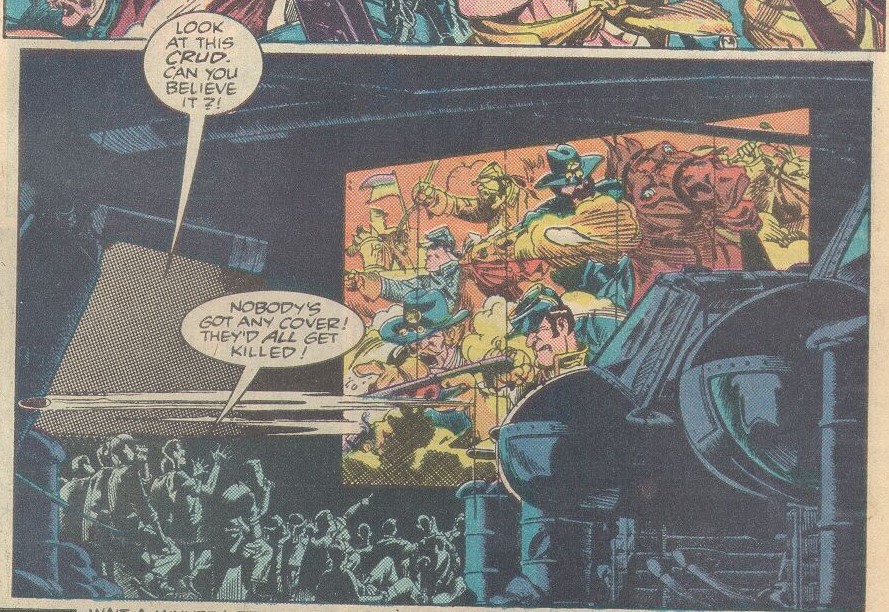
There are sounds and flashes as the VC fire rockets at the base, but too far away t bother the men at the movie. Mike tells Ed not to worry; Charlie doesn't get much R & R and attacking them would mean they don't get to see the movie. It's different here, than in The World.
The issue ends with an editorial that although the series is fiction, events within are based on actual events, like a contingent of the 23rd Infantry meeting up with Australian soldiers and searching through a system of tunnels. We are told that the passage of time will match the schedule of the comic, one month for each issue. It then ends with a glossary of terms, such as what the 1st sergeant meant when he read out Ed's personnel file: LPC, been through AIT, 11 Bush MOS. LPC=Leadership Potential Candidate, AIT=Advanced Infantry Training (combat training, after Basic), 11 Bush=light weapons specialist, meaning infantry weapons, ie a "grunt."
Doug Murray was a veteran of two tours in Vietnam (one full tour, one temporarily assigned duty, of about 3-4 months) and brought to it his experiences, along with editor Larry Hama's. Murray served in 1968-69, in the post-Tet Offensive, when things were really hot. Hama had served from 1969-1971, with an engineer unit. They brought an immediate authenticity of the veteran. Michael Golden never served in the armed forces; but, it was an area of interest for him and he did his research. he has a cartooniness that some decried; but, he had every piece of gear and every vehicle looking the way they did. he had the defensive positions displayed as they were, and he could tell a story. A vet could look at the comic and say, yeah, that's how it was.
So, we see the war, for the first time, from people who were there; warts and all. This isn't the gung ho stuff of the early-mid 60s, when the US was primarily in the advisor role and everyone talked about defending democracy from Communist aggression, ignoring that there was no democracy in the Republic of Vietnam, because they did not hold free elections, which led to the VC uprising. The Army isn't this grand, glorious group of crusaders. Ed sees that corruption undermines things, in the rear area, via the crooked 1st sergeant. We also see that the South wasn't particularly secure, as even the Saigon airport was the seen of rocket and mortar attacks.
This first issue features an FNG (Nis New and G is Guy...you can work out the F part yourself), on his first patrol, after landing in The Nam, over the course of his first month in-country. He is green as grass, prone to airsickness, has a fear of heights, and finds himself in a combat zone, probably not long out of high school. malt shops and fumblings in the back seats of cars to humping through rice paddies, sucking down treated paddy water, and a short, intense firefight That's a hell of a transition for anyone.
The second issue find Ed on an ambush of a VC supply route, as they hit a column of VC and their oxen with Claymore anti-personnel mines (a block of C4 plastic explosive, with ball bearings embedded in it, which are then fired in an arc, when the explosive is detonated, causing beaucoup damage) and small arms fire. Sgt Polkow has to put a foot up the ass of a reluctant medic to do his job and earns the wrath of the 1st sergeant, because the medic is one of his boys. The patrol gets 4 hours rest at base, after 3 days in the bush and then is sent out on APCs, along with a tank, to patrol another sector, where mine disables an APC and they end up in another firefight. When they return to base, Polkow goes looking for the Top and Rob, his clerk (who showed Ed to his platoon) calls for the platoon commander to try to defuse things. He finds Polkow confronting the Top, in the club and offers to buy him a drink, for the way his platoon acted on their mission. Polkow lets the Top go, for now, During their initial confrontation, when Polkow learns that they are headed back into the bush, after 4 hours sleep, we se the Top cleaning his Colt Python .357 Magnum revolver and then loading it, lest Polkow try anything. Later, when they have returned, Polkow hand his gear to a soldier and starts to head off with his weapon, then stops and tells the GI to take it, too. he knows he is in a dangerous frame of mind. Later, he goes looking for Top and Rob is seen calling the lieutenant, to keep Polkow, who the men respect, from killing the 1st sergeant.
Here we see that the enemy wasn't just the PAVN or the Viet Cong; sometimes it was the people in green uniforms, sitting in the rear. Just as petty minded managers an co-workers can sabotage chances at promotion at work, the same could get you killed, in a combat zone.
issue 3 sees Ed and Mike get Lonnie Crews, who is a short timer, a 3 day pass to Saigon, to celebrate his impending departure. first, they have to win enough in a poker game to bribe the Top for the pass; then, they have t survive Saigon. They take in a movie, where Lonnie stops Ed from buying what he thinks is popcorn, but is actually snails (escargot). During the movie, a terrorist tosses in a satchel charge, via an exit door. The three men leave before MPs arrive, so they don't spend the day helping to clear rubble and hunt for VC. they go to a nightclub, where they are soon joined by some "hostesses", who drink Saigon tea (tea, but at champagne prices) and they have a friend, for Ed. Ed is nervous and awkward and she suggests taking a walk, which makes Ed more relaxed...too relaxed to see it is a set up, for a mugging. Luckily, Mike and Lonnie followed and saved Ed from getting worse than a headache. They go to the Queen Anne hotel and get rooms and spend the night on real sheets. however, the hotel is bombed by the VC and Loonie is trapped under rubble. Mike and ed work to get him out from under it and get help from the fire brigade and get Lonnie to a hospital. He is injured, but alive and will get to go home early, as a result. Mike and Ed decide to head back to the base, when they are waylaid by "journalists," from Stars & Stripes.....
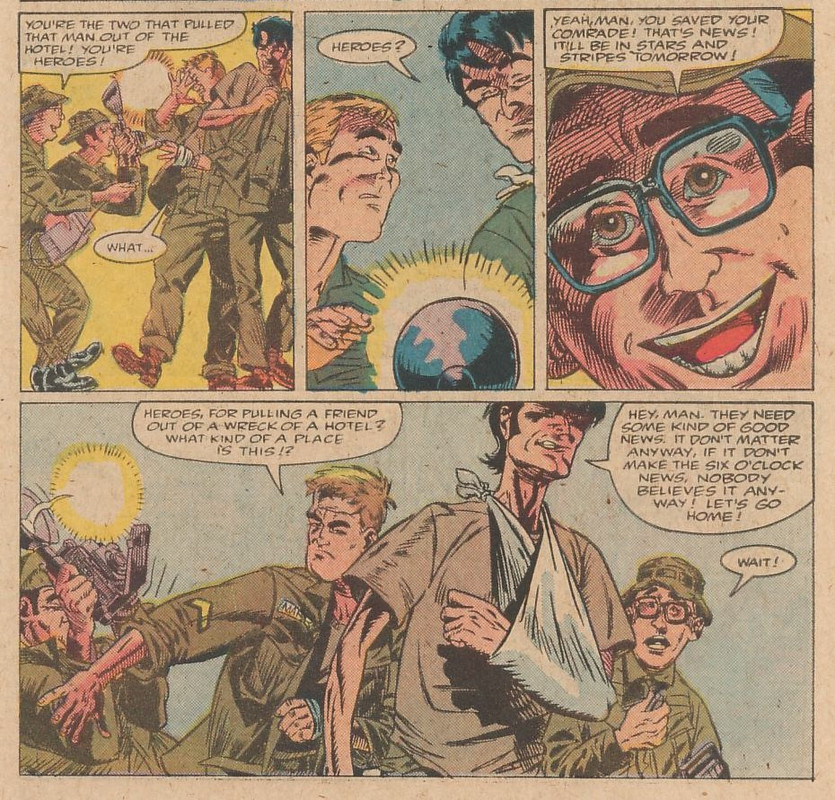
They return to base and crash in their bunks, just in time for the nightly rocket attack. They need an R&R from their 3-day pass!
Issue 3 also contains the first letters, including two from veterans, praising it, and a couple from sons of or brothers of veterans. Jane Fonda gets hauled out by one of the vets.
Here, we see that even a pass to Saigon wasn't an escape from danger, as Saigon was a target for bombings and assassinations, plus your basic street crime. A naive young GI, his first time away from home and the US, is a ripe target. We also see the disdain that many vets had for the media. This is an area of great controversy, in regards to the Vietnam War and the experiences during this period shaped how the military deals with the media, as well as how the government manages an alleged free press.
In Vietnam, the press was mostly free to cover the war, as they saw fit. Much of it was done from Saigon, sitting in hotel bars, writing copy to go along with Army infromation press releases and briefings; but there were also young, ambitious journalists who went out on patrols with GIs, looking to be the next Ernie Pyle. In previous wars, they were newspapermen and newsreel crews; in Vietnam, they were NBC and CBS News, as well as print and other journalists. Vietnam was the first war where families could see wounded soldiers being medevaced, on the 6 O' Clock News, with commentary from Walter Cronkite. In many ways, that was a good thing, as the populace could see the reality of the war and compare it to what was coming from Washington and decide for themselves if they wanted to see their sons and brothers fighting in a war that was essentially an internal struggle. For the military, it revealed how often they made mistakes and how costly they could be; but, it also brought them additional scrutiny beyond their superiors, as suddenly others wanted to weigh in on how they should conduct the war. They got enough of that from the Pentagon and the White House, let alone Congress; now, they had journalists and Mom & Pop weighing in. Imagine every conversation about what the coach should have done after your team lost a football game and then apply that same level of expertise to civilians telling trained soldiers how to fight a war.
A free press is necessary for a democracy to function; but, there were elements of that press in Vietnam who were more interested in selling a story than reporting the truth. journalism is rarely objective because it is always filtered through the eye of the reporter and their camera or illustration. Just as two eyewitnesses can see the same event and tell two different recountings, so can two jourbalists tell a story with their own biases and agendas. Major defeats become mild setbacks and bad momentary judgement becomes mass slaughter, depending on the story the journalist sends home. Sometimes it was true and sometimes it was like a Hollywood biopic, where minor elements have a basis in fact and the rest was made up to tell an entertaining story.
GIs were trying to stay alive another day and then seeing things like Stars & Stripes feeding propaganda, or newspapers from home where they might be painted as stormtroopers of a repressive regime. Then, they see images of protesters who are safe and sound at home, attacking them, rather than the politicians and opportunists who sent them there in the first place. It built up strong resentments in veterans, as they felt like the media painted everyone there as killers; or, alternatively, cheered on the slaughter. It was a lose-lose situation. The military and government learned that if they wanted to control public opinion and steer it in their favor, then they needed to control press access to the battlefield. In Grenada, they denied them access to it until well after there was a story to tell, other than the government press releases, which were carefully stage managed. In the Gulf War, it meant press pools, where reporters were given daily briefings that said nothing and had gun camera footage narrated to them, like it was a video game. When CNN reporters showed footage of rubble in Bagdad, they were labeled as traitors or victims of Iraqi propaganda, as the US would never bomb a "milk factory," ignoring the number of times it had bombed civilian targets or misidentified civilian areas as military locations. Laser-guided "smart bombs" are only as precise as the men who point the designators at the target.
From the other side of things, the footage from Vietnam woke up a lot of people to the idea that their government was lying to them and their children, siblings or neighbors were the ones coming home in boxes, for very murky reasons. They started to react to this situation and reject the government narrative. In 1968, it drove Lyndon Johnson from seeking re-election and it would play a major part in bringing down Richard Nixon's administration
It could be said that the free rein of the journalists allowed for a better democracy.
Issue 4 plays further on the idea of journalists in the field and finds a camera crew joining the 23rd on an operation. it also find the 1st sergeant joining them, in the field, to be seen on camer, while he leaves Polkow behind, to man the fort, rather than lead his platoon, in the field. They are choppered in to what is supposed to be a pacified village and run right into VC, with a quad .50 anti-aircraft battery....
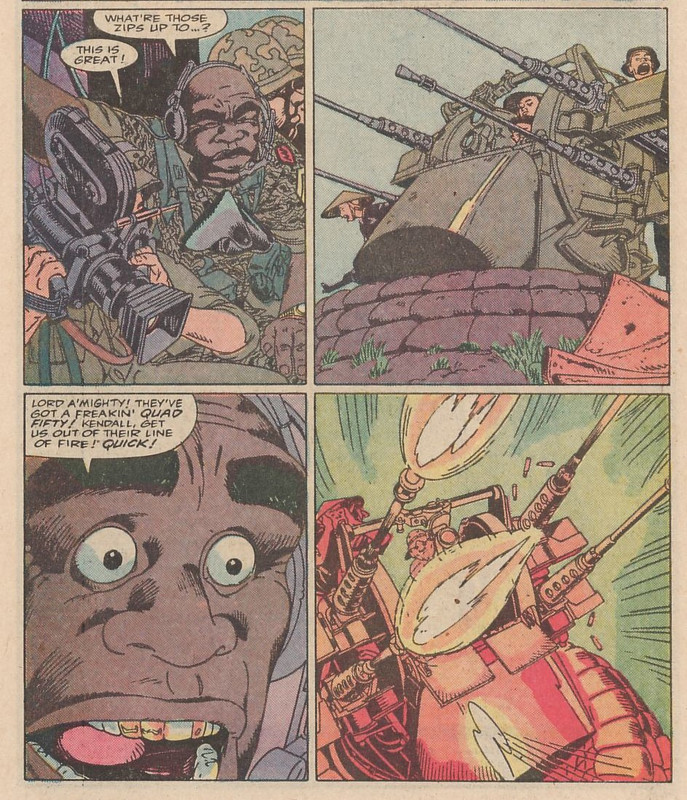
Ed's helo goes down in the woods, but he, Rob and a couple of others are unharmed. The group is pinned down and Top calls in a "fast mover' (fighter bomber) airstrike, of napalm, on the village. We see F-4 Pahntom IIs fly over and incinerate the village, while the news camera records. The troops are choppered out, but no one is tasked to search for Ed and Rob, despite Mike Albergo telling Top they can't leave them behind. The missing men trek through the jungle towards the coordinates of a First cavalry (Airmobile) base. Along the way, they encounter VC and Ed reacts like veteran, hitting a michine gun position with grenades and then treating Robb's wounds. they make it to the First Cav base and back home, while Rob tells of serving with the Top on a previous tour of duty and that he had been wounded twice before. When they return, he tells off the top and demands to be put with a line platoon or he is going to the captain with Top's corruption. Top sends him on his way, then puts Ed and Rob up for Bronze Stars. he also relays that the footage of the napalm attack was lost and only the shots of the briefing remained.
Here, we see how bad leadership can turn things into a fiasco and how troops often became self conscious when camera crews were in the field. it often endangered the men, as they became more conscious of the camera than potential danger. meanwhile, the Army tries to stage manage the footage to put themselves in the best light.
The events in the issue are centered on Operation Paul Revere/Than Phong 14, a combined US and ARVN mission to pacify large areas of the country, between May and September of 1966. When I was busy gestating.
Issue #5 finds Rob leading the squad , in the filed, as a new sergeant, while Top gets a new cler typist, one actually trained for the job. We also see new arrivals and one who isn't green and rebuff's Tops attempt at a bribe. We later see the new guy return, with the bribe Top was fishing for and receive, just as he is arrested for taking bribes. the clerk typist is an investigator, from CID, who set the new guy up with marked bills, to pass onto the Top. It's sort of entrapment; but it gets the job done. Turns out, Polkow arranged it, to finally deal with Top. Rob says it was working a desk that turned Top into what he became, after time in the field.
Issue 6 finds Ed experiencing the monsoon season, where everything is wet all day, every day, to the point of rotting his jungle boots. We also see Kakas, the medic who was in with Top, try to frag Sgt Polkow. he gets his payment in the field, after getting hit in a VC ambush. Rob continues to show that he is a good field leader.
Issue #7 is a departure, as it features a Kit Carson Scout. these were VC turncoats, who then worked for the Army, as interpreters, much like the Native American scouts who served with the US Army, during the Indian Wars of the late 1800s. The issue also features the first art from Wayne Vansant, as fill-in artist. Doug Murray adds a note that Duong, the Kit Carson Scout, is a composite of 3 actual VC, not all of whom were KCS.
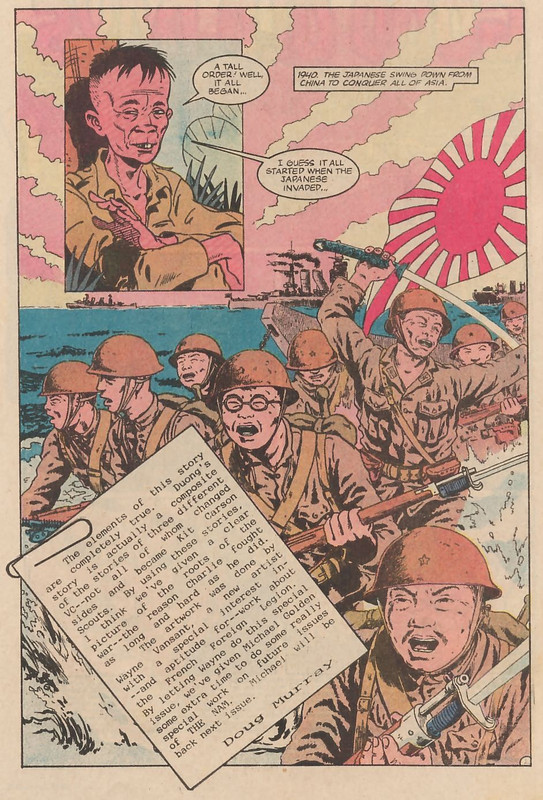
Through Duong's eyes, we see the history of the Vietnam War. First, in 1940, the Japanese come, after the French surrender to Germany and are forced to accept Japan as "co-rulers" of Indochina. Duong was a farmer, but the woman he loved, tried to resist and was executed. Duong joins the Viet Minh and fights a guerrilla war against the Japanese. After the war ends, their leader takes over the district and Duong goes back to farming and finds a new love. Then the French return, determined to reclaim their colony. Duong fights the French, but they bring in the Legion, with ex-Nazi soldiers among them....

The Legionnaires come to the village and question Duong, by stringing up his woman on their half track, threatening to kill her if he does not talk. The Viet Minh attack and Duong shows the Legionnaires the same mercy they showed his wife. The French are defeated at Dien Bien Phu and now they will be free.
Except it wasn't. The country was split, with the South controlled by French collaborators, like Diehm. they held a snap election and used violence to wipe out opposition. Te VC fought the oppressors, but Duong saw his brothers become oppressors, targeting those who were educated and using their might to get back at those they perceived as enemies, mostly for petty reasons. Then, the Americans came....
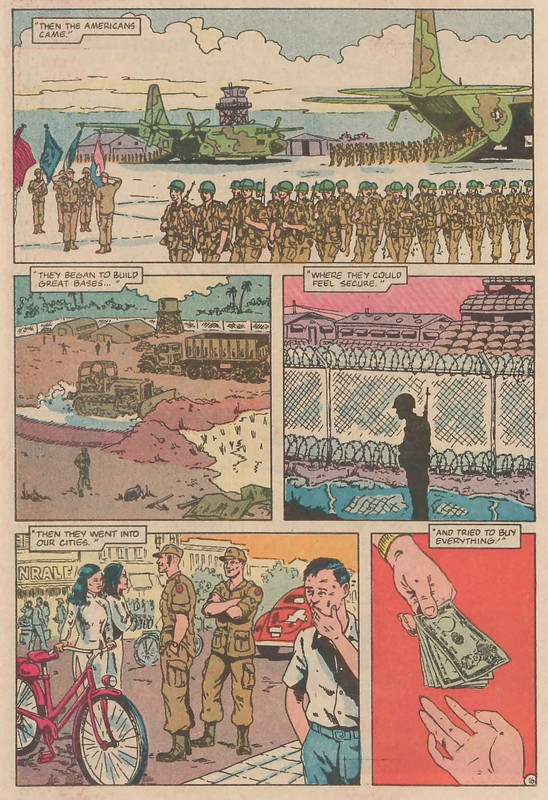
They weren't safe and secure. They got better at fighting, over time and some actually tried to help people....
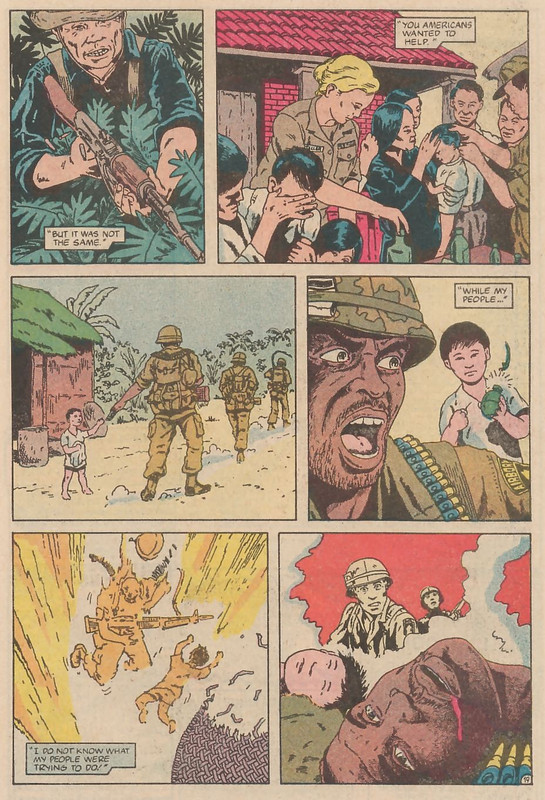
Duong became disenchanted with his war, as his brothers spend more time killing Vietnamese than outsiders. in the end, he decides to join the Americans and try to save some of them.
It's a powerful issue and one that harkens back to Archie Goodwin's story of the Vietnamese farmer, in Blazing Combat, who loses everything, when he just wants to be left alone to grow his crops. We see how the French, who controlled Indochina, were forced to allow in the Japanese, who exploited their resources for their war machine. A revolt broke out, led by people like Ho Chi Minh. The Japanese are defeated and the people who fought want to live their own lives; but the French return and the fighting begins again, until Ho Chi Minh's troops defeat the French, at Dien Bien Phu. the French were desperate to hold onto their empire that they even took former Nazi enemies into the Foreign Legion, and sent them to use the same tactics in Vietnam. Even in defeat, Vietnam is not free, as the Diehm faction, in the South, stifles any dissent and his "free elections" are a farce, leading the the rise of the National Liberation Front, or, as they were better known, the Viet Cong. The US sends advisors, then combat troops, hoping to control this part of Southeast Asia, as check against China and the Soviet Union. Duong and his people suffer; but Duong also see that his own people used their grievances to wage war on anyone who slighted them. Teachers and the educated are ideological targets, because they question the teaching s of Mao and Ho Chi Minh. The VC take what they want from innocent peasants, just as the Diehm government does. One group of thugs or another, it all seems the same. America adds a new outsider; but also programs to try to help people, to win "hearts and minds." Duong sees this as a better alternative to killing people because of inferiority complexes and ideologies that mask a system where a certain elite is still above others, no matter whose philosophy governs.
Troops like the Kit Carson Scouts were always outsiders, as they were turncoats and who is to say they wouldn't turn again? As such, they become men without a country; and, at the end of the war, they became targets. Once Saigon fell, old scores were settled, furthering an already exploding refugee crisis.
Wayne Vansant had done bits here and there, including a little work in the dying days of the Dc war books. He had done a couple of stories for Savage Tales and had a keen interest in the history of the French Foreign Legion. He was brought in to give Michael Golden a break and keep him on deadline; but, when Golden quit the series, Vansant found himself the regular artist. He did have Golden's flash; but, he was an excellent storyteller, with an eye for detail and thorough research.
Issue #8 finds the platoon coming across tunnels and a tunnel rat has to go down and check them out. He needs someone to act as communication and Ed volunteers. the tunnel rat shows him the dangers, beyond just the normal ideas of boobytraps...
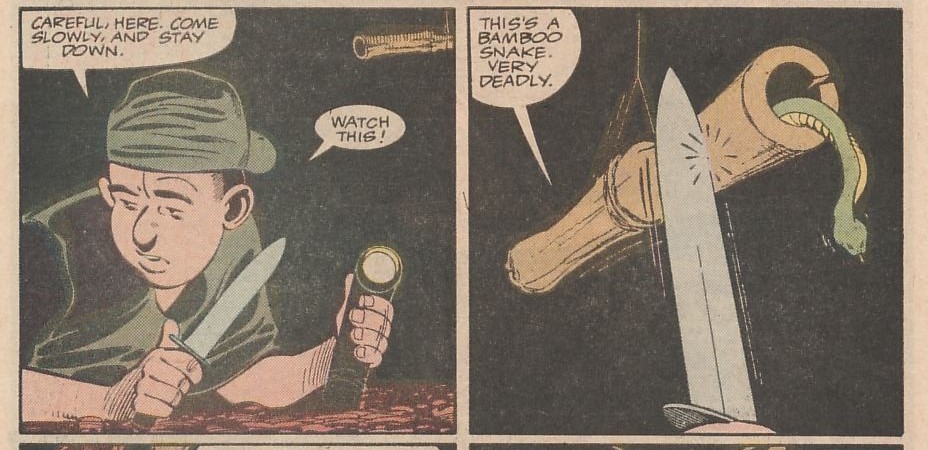
...venomous snakes, set up to be angered by some enemy, stumbling through the tunnel. They move on and run into a VC, who Ed shoots, but nearly gets hit, himself. They find a wider portion, which housed sleeping areas and work rooms and find a body and the tunnel rat shoots it. The flashlight shows it to be a woman and Ed is horrified, then more so when the rat shows his that she had a grenade taped to her belly, to go off when they approached. She was a deliberate boobytrap. They return to the surface and the tunnels are destroyed. The tunnel rat, Verzyl, talks of leaving soon and re-upping to join the Airborne.
The second part of the issue is the unpublished 3rd story of the 5th to the 1st, with the tunnel rat, Verzyl, and what happens to him, as seen in the last installment.
Issue 9 finds Ed in his last quarter of the war; but we learn that we shouldn't feel safe, as we watch the 23rd move into to reinforce a push on on area alive with activity. it turns out to be a VC command post and they are determined to hold it and the fighting gets down to the last magazines for their M-16s, before help comes. Just as things seem safe, a sniper kills Mike and Ed suddenly learns what it is like to lose a buddy...
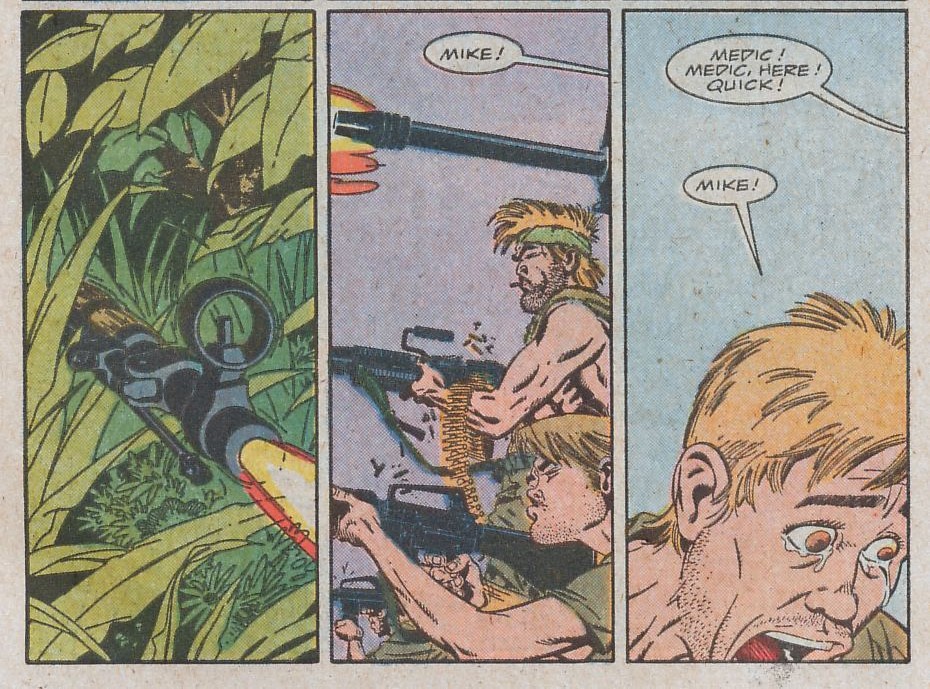
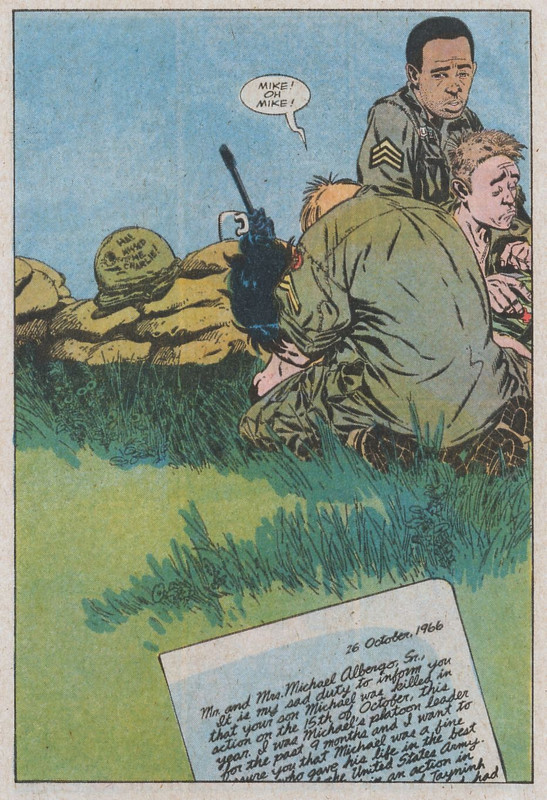
All along, we had seen Ed and his buddies survive and come back. Now, we know what it is like when they don't.
Issue #10 finds Ed a mess, on a bender after the death of Mike. They are assigned to back up the ARVN Rangers on security duty, in Saigon, on National Day. Ed witnesses an attack and the ARVN Ranger response of firing into a crowd. Back at base, he gets an education and we get the first hints of the racial inequality in the US draft system....
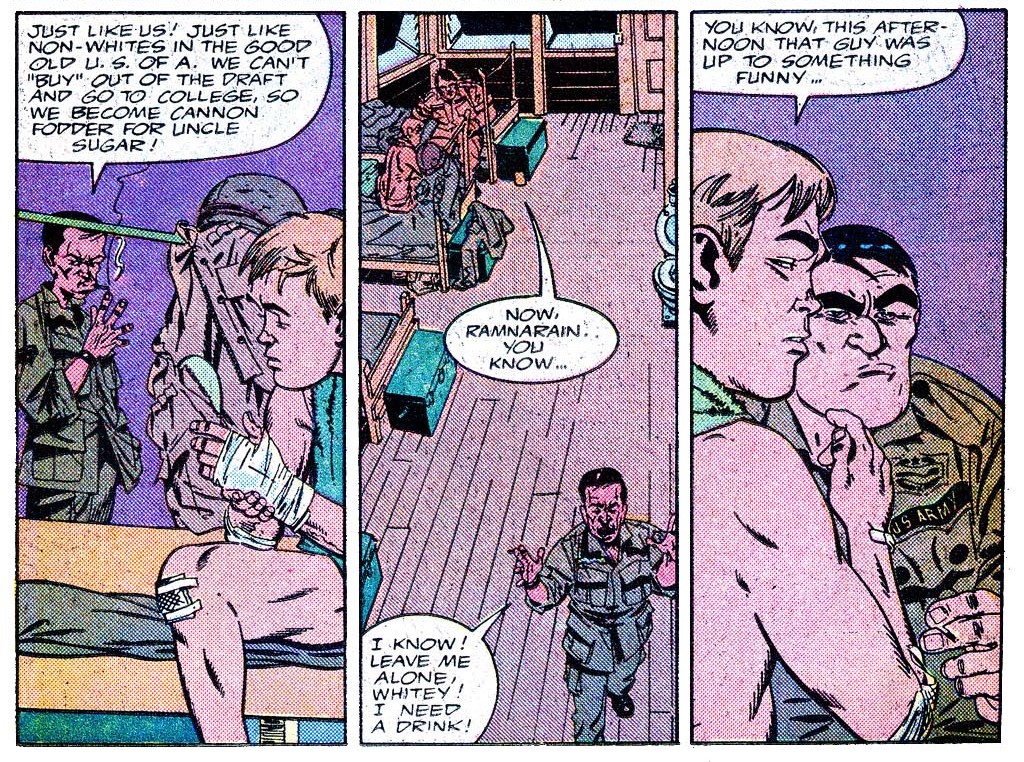
Ed also witnesses Ramnarain, one of the recently arrived guys (on a second tour) acting strangely, talking about making money. Later Rob sees that the gift of a chocolate bar is just feeding the local economy and everything is up for sale. Ramnarain is making money off of it by selling chocolate and cigarettes fromt he PX to the civilians, at inflated prices. We see an attack on Ton Son Nhut Airbase and Ramnarain is missing. Back on security duty, Ed witnesses a prostitute attacking an airman, who tried to stiff her on payment. The guy smacks the woman and Ed hits him in the gut with his rifle butt and lets the womantake her money. he then gives a kid chocolate. They return to find Ramnarain, facing an Article 15 (Non-Judicial Punishment), where his fine is likely to match his earnings. Ed has come out of his funk, but has seen the corruption of Vietnam. He also realizes that he has broken 90 days and is officially "short."
The issue also conatins a letter from a woman, whose brother was drafted (yup) into the Marines and stationed in Da Nang, while she was too young to understand the war. She praises the book for helping her understand what he went through and tells of giving copies to her brother and her niece and nephew, so they know what their father experienced.
Issue #11 has one of the best covers....

It captures the look of veteran soldiers, in a quiet moment. Ed is no longer the green FNG, fresh from Ft Lewis, who gets airsick. he is a seasoned combat veteran, nearing the end of his tour.
The issue is set in December of 1966 and I am in diapers, literally enjoying mother's milk. The guys decorate the barracks with A-wipe and whatever else they can find. Ed has "42 and a wake up;" Rob has extended. Ed questions why. There is no college for him and another year and he will be an E-6 and can return to the states as an instructor. For him, it makes sense.
Rob and Ed go to hear Cardinal Spellman speak and hear him claim that Vietnam is a war to preserve civilization. Ed is troubled, as that is not the message he was raised with, in his church. rob tells him to forget it, that Spellman is an Army lifer and just like the rest. They take in the club and find out there are American dancers from the USO, of the female persuasion. Needless to say, the club is packed (as are the dancers). Christmas Eve sees the VC violate a truce and launch an attack. Santa comes to their aid with gunships and Christmas morning sees the smoke rising over the killing ground. The return to find their barracks hit by rockets and Ed's Christmas card destroyed. ed is down, but Rob tells him to get a shower before the kids arrive for Christmas dinner, from the village.
As they sit down to a turkey dinner, one of the kids pulls out a grenade and pulls the pin. Ed asks the question on all our minds...

Ed receives bright moment, as mail call arrives, with a cake from his mother. He passes it around to the squad. They go out on a fruitless op, then celebrate New Year's Eve with another attack on the base. they finish the year by see their radioman, Thomas, off on his journey back home. It will be Ed's turn, next.
The letters page also gives a shout out to other Vietnam comics out there, such as Vietnam Journal an In Country In Country was an indie comic, which I never saw and do not have issues for, nor have I found scans. i will get to Vietnam Journal, soon.
Issue #12 finds John Severin on art, and Ed about to go home. We see a letter he has written home, about his time in Vietnam, juxtaposed against images of an operation to clear a suspected VC village. The troops mount up in Hueys and artillery unleashes a barrage on the village, then the choppers land troops....
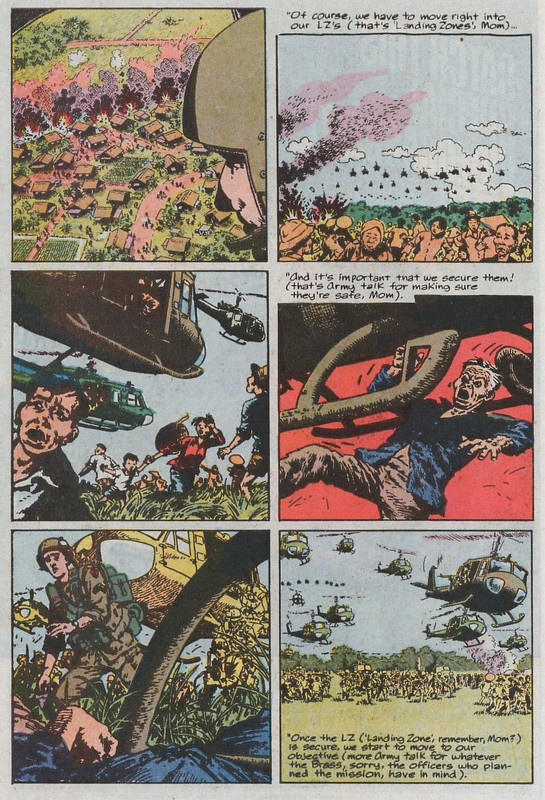
They clear the village, then the A-4s come in to level it. The soldiers go in and search and find caches of supplies and arms. They also find trapdoors and tunnels and a firefight ensues. A prisoner is taken and is shot in the head, by an intelligence officer. They withdraw and the arms and ammunition are blown up and the only sign there was a village there is a scroched patch of earth, seen from a helicopter.
Issue 13 is the end, as we see Rob send of the captain, back to the states and pick up the new guys. he brings them back to barracks and they are introduced to Ed (12 days and a wake up) and the others. Ed is the veteran. now. Ed finds himself re-experiencing his first days, fromt he other side. he also finds himself in the bush again and he isn't happy. he just wants to get home. As they patrol, the air force drops defoliant, and Ed remarks that it feels cool, as they pass through it. Ed goes out on another op, then falls to within one week of leaving and is held off of ops and must sit at the base, waiting for his buddies to return. Ed and Rob share a beer, then Ed packs his gear. When Rob and the others return, they take him to the club to celebrate, then to the nearby village, where a surprise has been prepared. Ed wakes up in the village with no memory of how he got there, though the lady was very nice to him. Sgt Polkow says goodbye to Ed and Rob takes him over to Tansonnhut airbase.

This was Michael Golden's last issue and it was a fitting end, as Ed ends his tour, says goodbye to his buddies and returns to "The World."
Over 13 issues, we watched Ed Marks, young kid from Philadelphia grow from a wide eyed kid, into a seasoned veteran, of a war where kids are used as weapons, villages are leveled to save them, and the people they fight with would just as soon kill their own people as the enemy. The question becomes, how will Ed adjust? How do you go from insanity to "civilization," in the course of an airline flight? What kind of wounds do you carry with you.
The Nam went a long way in showing the average reader what the Vietnam experience was like for those who were sent over to fight. It doesn't represent everyone's experience, but it is fairly typical of many.
The series continued without Michael golden and without Ed. we first get an intro to the new guys in Rob's squad, then issue 15 checks in on Ed's arrival home...

This cover caused a bit of a stir, as Eclipse editor cat yronwode felt that the hippie, was a caricature of herself. It wasn't meant to be; but, it sure fit.
The issue features Rob reading a letter from Ed, about his time back home. Ed is a drill instructor, at Ft Jackson, South Carolina. he describes returning to McChord air base and no welcome. They were ushered off a plane, taken to a room and told to dump out their gear, as they were searched for contraband (drugs). Ed then gets his orders, back pay and leave to visit home....

De sees protests of Dow Chemicals, about napalm and can't under stand; napalm had saved their butts, in the bush. he visits some old friends; but they had changed...or he had. A visit to an old girlfriend finds her now a mother. Ed watches the news, but can't believe his eyes....
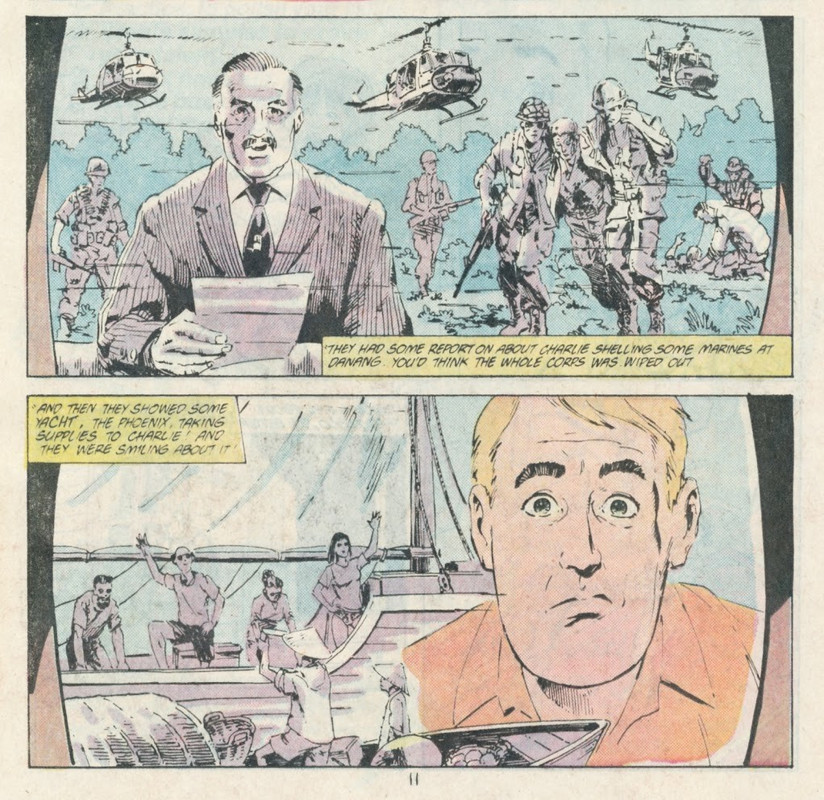
Ed travels to his new duty station and gets acclimated. some of the other members of the cadre were in-country and some are having problems adjusting. The new troops include a misfit kid, who can't qualify on the range and nearly shoots the DI. he gets discharged and is beside himself because he believes in the war. Ed thinks the country is going crazy and no one is telling what really goes on in Vietnam and makes the decision to become a writer and journalist, to tell the story.
The Nam continues as a series, but it never tops these first 13-15 issues. This gives us the story of what it was like, through Ed's eyes, from arrival, to returning home and trying to readjust to a world that was different than a year before. Issue 15 features how some of the protests seemed unbelievable to veterans. protesting the makers of weapons that saved their lives? little did they know how some of those were used and how that cool defoliant would kill so many. Ed sees people who got on with their lives while he was gone for a year and people who wanted to go to war, but weren't suited. It is no wonder he thinks the world had gone crazy. he remarks of an attack at Da Nang that is reported like massacre, rather than a violent, but short fight.
Finally, someone was telling the story from the POV of those who were there, a phenomena that was happening in books and film, and even television documentaries, as veterans started to speak and to write. maybe time just needed to pass before people were ready to listen, or maybe the vets needed time to speak. Maybe it was the change in the culture or maybe people came to realize that they had done a disservice to those who were sent to war, many without choice and then were treated like leppers when they returned, or were made to feel that way, in their own heads. A lot of guilt started to come to the surface in the 80s. Some turned it into revisionism of having won the battles but lost the war due to leadership not having the will to win. Others saw it as a political mess that destroyed a generation of lives, through death and physical and mental scars, political divisions, economic turmoil, refugee crises and bad drama. maybe now, some healing could commence.
It was this period that ultimately led to the Vietnam Veterans memorial wall, in Washington DC. In 1979, a fund to establish a memorial was established. A competition was held to design the memorial, won by Maya Lin. Lin was the daughter of Chinese immigrants, who grew up in Ohio. he submission was of a black granite wall, rising out of the earth, like a knife, bearing the names of those who died in Vietnam, rising to the heart of the war and dropping off to the end of the conflict. A simple design that is unbelievably striking. There, people can reach out and touch the name of a friend or loved one, taken in the war. People make rubbings on the names and leave tributes to their friends and family. It is a place of healing.
When I was a midshipman, the moving version of the memorial was brought to the Univ of Illinois campus, and we midshipmen and other ROTC cadets acted as guides and stood vigil over the names of those who proceededus. We helped guide people to the names of friends and family and stood buy as they made connections. It was a very moving experience.
The granite of the actual memorial has a reflective polish that allows people to be seen with the names, as they become a part of the fallen. Items left behind have been preserved and cataloged to tell those stories, for future generations.

The series continues, first using Rob as a POV character, then switching to others. It eventually moves to the Tet Offensive and the fighting that ensued to retake the areas that the VC hit. Sales dropped off after Michael Golden departed and there was pressure more and more to make the book more commercial. For a time, it focused on a special operations force. Some editorial forces wanted to put superheroes into the book and set it within the Marvel Universe. this was fought and a compromise of Marvel comics being read there, imagining if superheroes were in Vietnam. Larry Hama stepped away from the book and Doug Murray found himself more and more getting into fights over the direction of the book, as they wanted to put the Punisher into it. Finally, things came to a head an Doug Murray left the series and was replaced by Chuck dixon, a writer who never served in the military. Dixon at least did his research; but, it became something else and lost its core.
Eventually, the Punisher was inserted in the comic and it was decried by fans. it didn't help that he is shown chained up in a cave, tortured, then snaps the enck of his torturer, with his legs and escapes. It was Hollywood BS and it had nothing to do with the reality that had been a hallmark of the series.
After that fiasco, veteran Don Lomax, creator of the indie comic Vietnam Journal, was brought in to try to turn things around. however, Lomax was operating under Code restrictions that did not inhibit his own series.
Ed Marks was brought back as a journalist, reflecting Lomax's character Journal, who was the POV in his own stories. We check in with rob, back in Baltimore. Lomax tried, but the end was in sight.
The Nam proved to be arguably Marvel's best book of the 80s, as it dealt with real life, with real drama and educated a new generation of what their fathers and older brothers went through. It doesn't cast one side of the debate as right or wrong, just presented the experiences of those that were sent to Vietnam and let you come to your own conclusions. They knew what they saw and what they saw stayed with them the rest of their lives.
Next time: We aren't quite done with Doug Murray, as he had one more Vietnam Story to tell and would do so, in a graphic novel, for Marvel. next time, we look at Hearts and Minds, a graphic novel of the Vietnam War.





